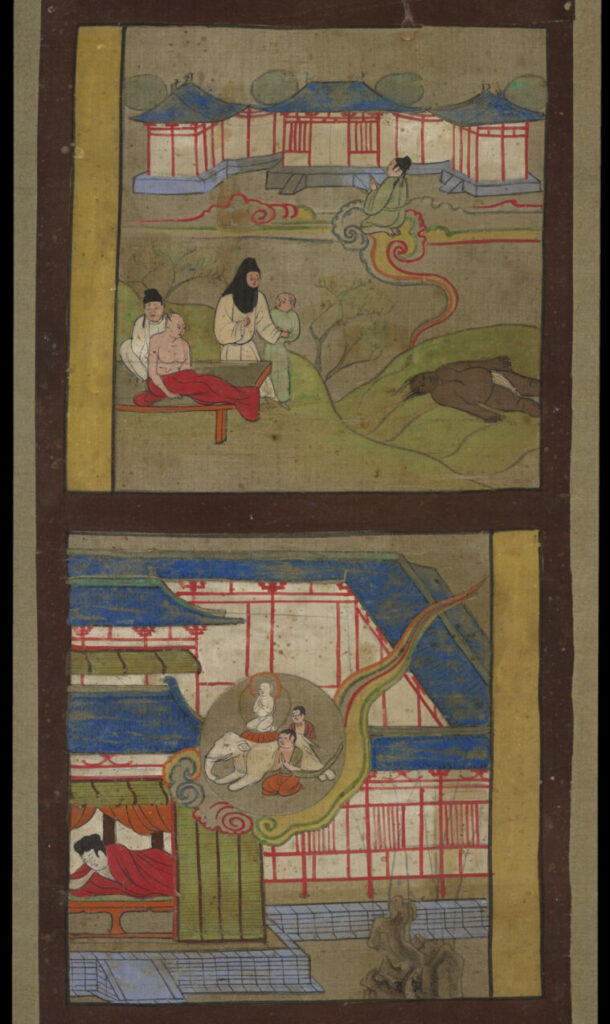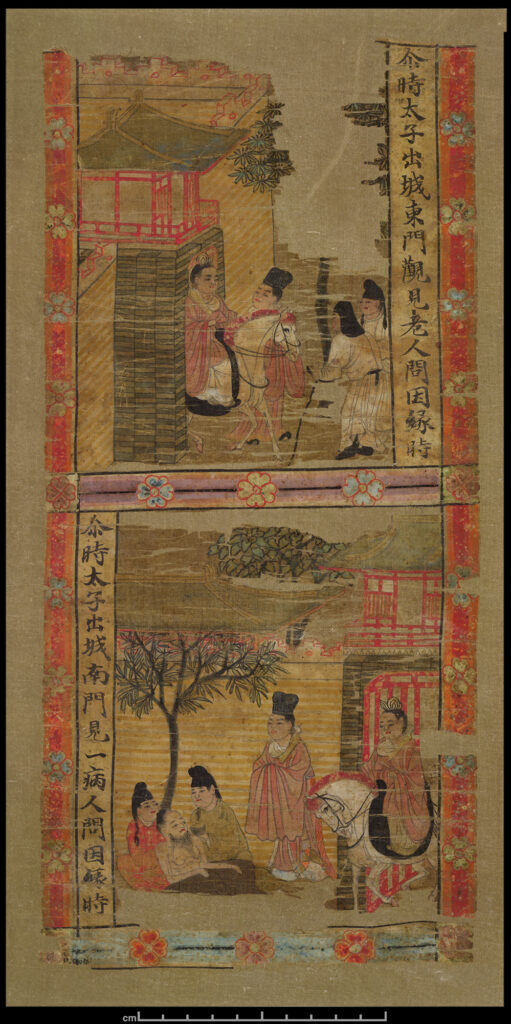About Buddhism
The origins of Buddhism
Buddhism is a major global religion that originated in Northern India between the late 5th or 6th centuries BCE. It was founded by Siddhartha Gautama, who would come to be known as the historical ‘Buddha’.
Prince Siddhartha
The Birth of Sakyamuni
This painted silk banner depicts four scenes from the final rebirth of the Buddha as Siddhartha Gautama or Sakyamuni. The banner was discovered in Mogao Cave 17, or the ‘Library cave’, in Dunhuang. The narrative scenes are arranged vertically, and begin from the top of the banner. Shown here are scenes two and three, and the full banner can be viewed in the IDP database.
The first scene is said to represent Dipankara’s prediction of the birth of Sakyamuni. In Buddhism, it is believed that there have been many Buddhas before Gauntama Buddha, and there will be more in the future. Dipankara is a Buddha of the distant past. According to Buddhist legend, Dipankara predicted that an ascetic named Sumedha would become the Gautama Buddha in a future lifetime. Here, Dipankara is shown touching the head of Sumedha.
In the second scene, the boy is now an old man and shown on his sickbed. To the left of this image is the body of the man in death. Above this, the man’s spirit, or the spirit of the Buddha, floats on a cloud.
Pictured in the third scene is a figure riding a white elephant, floating on a cloud toward a palace where Siddhartha Gautama’s mother Queen Maya sleeps. According to Buddhist legend, the conception of the Gautama Buddha occurred when Queen Maya dreamt of a white elephant descending from heaven and entering her side. The final scene depicts the queen’s confinement in pregnancy.
Siddhartha was born in Lumbini, near Kapilavastu on the present-day Indian-Nepalese border. The exact date of his birth is unknown, but it is generally considered to have taken place sometime between the 5th or 6th century BCE. The teachings of Buddhism were not written down until centuries after Siddhartha’s death. As a result, the story of his life is usually told as a mixture of historical fact and legend.
According to legend, Siddhartha was a prince of the Shakya people, who lived a sheltered life of luxury in his father’s palace. Aged 29, Siddhartha became curious about life outside the palace walls, and became aware of human suffering for the first time. He had four encounters in the outside world that would change his life. He saw an old man, a sick man, a corpse and a serene holy man. From these experiences, he learnt that life is full of suffering, is impermanent and eventually comes to an end. He noted that the holy man seemed unaffected by these traumas. He decided renounce his lifestyle and embark on his own spiritual journey to understand human suffering and how it may be endured and transcended.
The Buddha
Siddhartha firstly attempted to practice an ascetic lifestyle, meaning that he gave up material possessions, fasted, and lived a life of abstinence. Through disciplining his body, he could pursue spiritual discipline. Legend says that he survived on one grain of rice a day.
Siddhartha gave up this extreme lifestyle after six years, and pursued a ‘middle path’ between indulgence and deprivation. He sought shelter under a Bodhi tree to meditate, and eventually at the age of 35, he achieved enlightenment, subsequently becoming known as the Buddha, or the ‘Awakened One’. As he belonged to a people called the ‘Shakyas’, he became known as Shakyamuni, ‘the sage of the Shakyas’. From this moment, the Buddha devoted the rest of his life to alleviating the suffering of others through teaching them how they also can reach enlightenment. This was effectively the birth of the Buddhist religion.
Siddhartha’s encounters with human suffering
This 8th or 9th-century painted silk banner shows two scenes from the life of the Buddha. It was discovered in Mogao Cave 17 at Dunhuang. The two scenes, stacked one of top of the other, depict two of the four encounters made by Siddhartha Gautama when he left the palace.
According to Buddhist legend, the historical Buddha was born a prince known as Siddhartha Gautama. He lived a sheltered life of luxury in his father’s palace. Aged 29, Siddhartha became curious about life outside the palace walls, and became aware of human suffering for the first time. He had four encounters in the outside world that would change his life. He saw an old man, a sick man, a corpse and a serene holy man. From these experiences, he learnt that life is full of suffering, is impermanent and eventually comes to an end. The banner depicts the prince on his white horse encountering old age and sickness, two of the four encounters that caused him to leave the palace for good.

